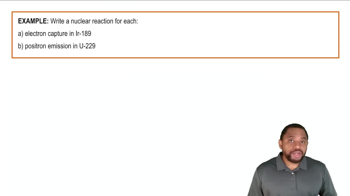Draw an electrolytic cell in which Mn2+ is reduced to Mn and Sn is oxidized to Sn2+. Label the anode and cathode, indicate the direction of electron flow, and write an equation for the half-reaction occurring at each electrode. What minimum voltage is necessary to drive the reaction?
Ch.20 - Electrochemistry
Chapter 20, Problem 98
What products are obtained in the electrolysis of a molten mixture of KI and KBr?
 Verified step by step guidance
Verified step by step guidance1
Step 1: Understand the process of electrolysis. Electrolysis is a process that uses an electric current to drive a non-spontaneous chemical reaction. In this case, the electrolysis of a molten mixture of KI (potassium iodide) and KBr (potassium bromide) will produce elemental potassium, iodine, and bromine.
Step 2: Identify the ions present in the molten mixture. The molten mixture of KI and KBr will contain K+ ions, I- ions, and Br- ions.
Step 3: Determine the reactions at the electrodes. At the cathode (negative electrode), the K+ ions will gain electrons to form elemental potassium (K). This is a reduction reaction. At the anode (positive electrode), the I- and Br- ions will lose electrons to form elemental iodine (I2) and bromine (Br2). These are oxidation reactions.
Step 4: Write the half-reactions. The half-reaction at the cathode is K+ + e- -> K. The half-reactions at the anode are 2I- -> I2 + 2e- and 2Br- -> Br2 + 2e-.
Step 5: Combine the half-reactions to get the overall reaction. The overall reaction is 2K+ + 2I- + 2Br- -> 2K + I2 + Br2.

Verified Solution
Video duration:
7mWas this helpful?
Key Concepts
Here are the essential concepts you must grasp in order to answer the question correctly.
Electrolysis
Electrolysis is a chemical process that uses electrical energy to drive a non-spontaneous reaction. In this process, an electric current is passed through an electrolyte, causing the decomposition of the compound into its constituent elements or ions. The products formed depend on the nature of the electrolyte and the electrodes used.
Recommended video:
Guided course

The Electrolytic Cell
Ionic Compounds
Ionic compounds, such as potassium iodide (KI) and potassium bromide (KBr), consist of positively and negatively charged ions held together by ionic bonds. When molten, these compounds dissociate into their respective ions, allowing them to conduct electricity. The behavior of these ions during electrolysis is crucial for predicting the products formed.
Recommended video:
Guided course

Ionic Compounds Naming
Electrode Reactions
During electrolysis, reactions occur at the electrodes: oxidation at the anode and reduction at the cathode. For a molten mixture of KI and KBr, potassium ions (K+) migrate to the cathode to gain electrons, while bromide (Br-) and iodide (I-) ions migrate to the anode to lose electrons. The specific products formed depend on the relative reactivity of the ions involved.
Recommended video:
Guided course

Electron Capture & Positron Emission Reaction Example
Related Practice
Textbook Question
1088
views
Textbook Question
Write equations for the half-reactions that occur in the electrolysis of molten potassium bromide.
1527
views
1
rank
Textbook Question
What products are obtained in the electrolysis of molten NaI?
1415
views
1
comments
Textbook Question
Write equations for the half-reactions that occur at the anode and cathode for the electrolysis of each aqueous solution. a. Ni(NO3)2(aq)
3028
views
Textbook Question
Make a sketch of an electrolysis cell that electroplates copper onto other metal surfaces. Label the anode and the cathode and indicate the reactions that occur at each.
886
views
Textbook Question
Silver can be electroplated at the cathode of an electrolysis cell by the half-reaction: Ag+(aq) + e– → Ag(s) What mass of silver would plate onto the cathode if a current of 6.8 A flowed through the cell for 72 min?
2188
views
